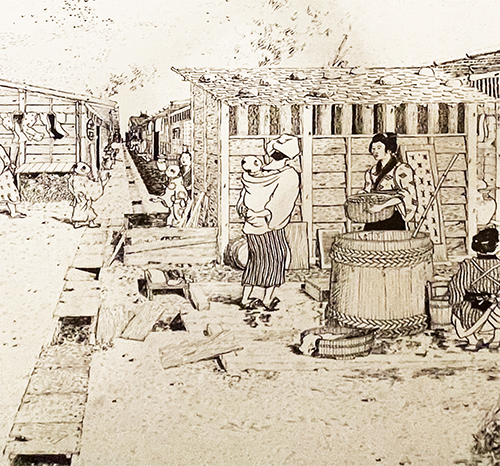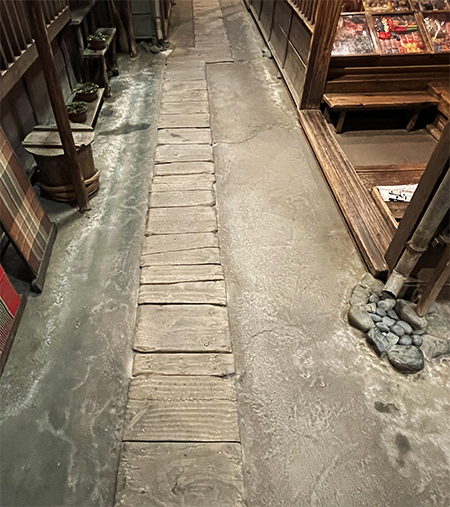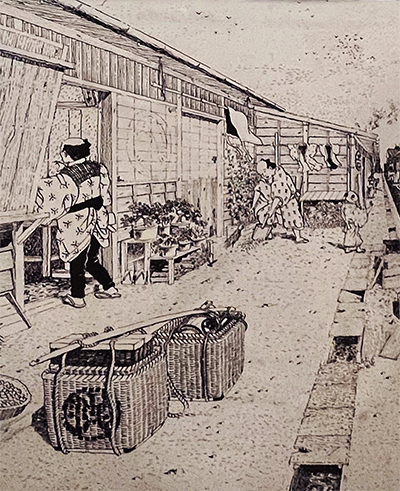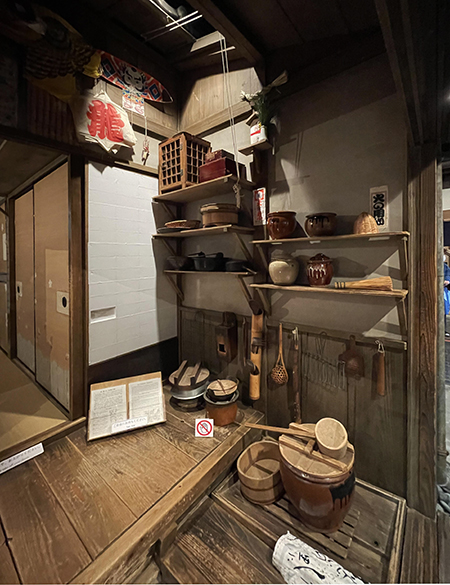


居住環境と人びとの暮らしぶりの探究を長い仕事人生でわたしは行ってきたと思います。通常業務では編集長職も昨年中に後進スタッフに移譲している。しかしやはり終のテーマとしては、ずっと頭のなかにあり続けていくのでしょう。現代の暮らし、家のいごこちの科学的探究と、暮らし方の進化の探索はこれからもメインテーマであることは間違いない。
一方で加齢と共に徐々に、来し方のことの想像力に志向が向かってきています。現代と未来の人間の暮らし方の根幹には、昔人が積み重ねてきた「生活文化」がそこにあり、その強い影響が家づくりのベースを構成していることに気付き深く興味が湧いてくる。古民家探訪にはそういった原意識があると思います。
先般から見て来た江戸由来の東京の「下町長屋」の暮らしぶり。台東区立下町風俗資料館の展示に添って江戸期の様子も確認してみたい。わたし自身がタイムスリップして江戸期に生まれ、そして現代と同じように居住環境についてのメディアを家業とするとしたら、やはりこの「下町長屋」という都市住居の基本について旺盛な興味を持ったに違いないと思っているのです。
そういった興味から、江戸期の様子の絵画パネル表現に強く惹かれていた。以下に展示パネル説明文引用。
「江戸の町人の大半が住んでいたのは裏長屋で、通りに面した木戸をくぐると路地があり、そこに軒を連ねて裏長屋が並んでいた。〜路地は長屋住民の共有通路。狭い住環境のため、路地は多目的に利用され、物売りの市、子どもの遊び場、夏には演題を出して夕涼み、そして井戸端会議の広場にもなった。」

「長屋は平屋建てで9尺2間と言われるように3坪から5坪程度の居住面積の長屋であった。勝手の入口を入ると4畳半か6畳間があり、勝手のへっついの上には煙出しの引き窓、座り流しには水瓶が置かれていた。」
いや、現代の暮らしぶりのマザーがリアルに存在している。当たり前だけれど人間の暮らしに不可欠な要素がコンパクトにまとめられて、機能としては過不足なく成立されている様子がよくわかる。そして狭さについては独特の「下町人情」がそれを補完して、いわば集合知としての人間環境を作っていたといえる。
いま現代の住環境創造のなかで達成すべきものは住宅性能に関することが大きいけれど、地域としてはほぼ高断熱化が進んだ北海道では、むしろこうした「社会環境」の知恵での総合的な未来型人間環境の価値感が高まっているように思っている。北海道では少なくとも意識に於いてはそういった段階にあるのだろう。もっといごこちのいい社会環境を考えたら、下町人情という領域は巨大な宝庫。
こういった江戸期由来の庶民の暮らし方のエッセンスから学ぶべきことは多いと思う。
English version⬇
The Reality of Edo Folk Life: Exploring the Shitamachi Row Houses-5
The way to futuristically enrich the local environment may be a soft sense of value like “downtown humanity. A downtown community with an expanded area. …
I believe that I have been exploring residential environments and people’s lifestyles for a long time in my work. In the past year, I have transferred the position of editor-in-chief to a junior staff member in the normal course of business. However, it will continue to be in my mind as a theme for the rest of my life. The scientific exploration of modern living, the comfort of home, and the search for the evolution of living styles will undoubtedly remain the main theme.
On the other hand, as we age, we are gradually becoming more oriented toward the imagination of what is to come. I am deeply intrigued to realize that the “lifestyle culture” accumulated by people in the past is there at the core of the modern and future human way of living, and its strong influence constitutes the base of house building. I believe that such an original consciousness exists in exploring old private houses.
The way of life of “downtown row houses” in Tokyo of Edo origin that we have been seeing for some time now. I would like to confirm the Edo period conditions along with the exhibition at the Taito City Museum of Shitamachi Customs and Folklore. If I were to travel back in time and be born in the Edo period, and if I were to make my family business of media about living environments, as I do today, I am sure that I would have a keen interest in this basic urban dwelling called the “Shitamachi Nagaya”.
Because of this interest, I was strongly attracted to the painted panel representation of the Edo period. The following is a quote from the exhibition panel description.
Most of the townspeople in Edo lived in back row houses. When you passed through the wooden door facing the street, there was an alley, and the back row houses were lined up in rows of eaves. 〜˜The alley is a shared passageway for the tenement residents. Because of the narrow living environment, the alleys were used for many purposes, including peddler’s markets, children’s playgrounds, cool evenings in the summer with a performance, and squares for well-meetings.”
The row houses were one-story structures with a living area of about 3 tsubo to 5 tsubo, or 9 shaku 2 ken, as they were called. Entering the entrance to the winch, there was a four-and-a-half or six-mat room, with a sliding smoke outlet window above the winch and a water bottle in the sink.”
No, the mother of the modern way of life exists in real life. It is obvious that the elements essential for human life have been compactly put together, and the functions have been established without excesses or deficiencies. The smallness of the house was complemented by the unique “downtown humanity,” so to speak, creating a human environment of collective knowledge.
Although the main focus of today’s housing environment creation is on housing performance, I believe that in Hokkaido, where the region has become almost completely insulated, there is a growing sense of the value of a comprehensive future human environment based on the wisdom of such a “social environment. In Hokkaido, at least in terms of awareness, this is probably the case. If we think of a more comfortable social environment, the area of downtown humanity is a huge treasure house.
There is much to be learned from the essence of the common people’s way of life that originated in the Edo period.
Posted on 2月 9th, 2023 by 三木 奎吾
Filed under: 住宅マーケティング, 日本社会・文化研究







コメントを投稿
「※誹謗中傷や、悪意のある書き込み、営利目的などのコメントを防ぐために、投稿された全てのコメントは一時的に保留されますのでご了承ください。」
You must be logged in to post a comment.